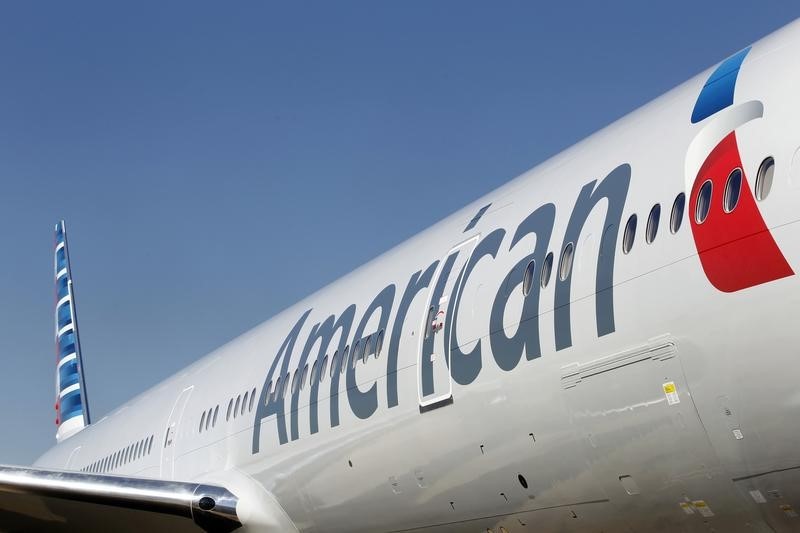Investing
American Airlines’ reliance on partners faces test after court ruling

© Reuters. FILE PHOTO: An American Airlines Airbus A321-200 plane takes off from Los Angeles International airport (LAX) in Los Angeles, California, U.S. March 28, 2018. REUTERS/Mike Blake
By Rajesh Kumar Singh
CHICAGO (Reuters) -American Airlines’ plan to grow revenue by relying more heavily on alliance partners to ferry passengers in uncompetitive markets while bulking up flights to U.S. Sunbelt states has been called into question by a U.S. court ruling blocking a key tie-up.
A U.S. federal judge last month ordered the company to end its alliance with JetBlue Airways (NASDAQ:) Corp, saying the partnership “substantially” diminished competition in the domestic market.
The alliance allows the carriers to coordinate flights and pool revenue. It also is a big piece of American’s strategy to compete in the New York market, where it was losing money.
Since the partnership started, American has ceded domestic capacity out of New York to JetBlue. It has allowed American to move away from unprofitable routes while maintaining a presence in New York. The alliance also enables the airline to feed traffic to its global partners who fly into the region.
If the alliance is dissolved, it will likely be forced to rebuild its capacity or cut international flights out of the region.
When asked about options Wednesday at an investor conference, CEO Robert Isom declined to share details, saying “there’s a lot to be worked out.”
The company has called the ruling “wrongly decided” and plans to appeal, but its executives don’t see a material impact to the company’s earnings as the court’s order is not expected to have ramifications beyond New York.
American has not specified the JetBlue alliance’s contribution to its earnings. But in its ruling, the court said JetBlue owed American a transfer payment upwards of $200 million at the end of 2021 as part of the deal’s revenue-sharing agreement.
Before the JetBlue court ruling, Chief Commercial Officer Vasu Raja, who is steering American’s strategy shift, told Reuters that the company is focused on markets where it can create “outsized value” for customers and will rely on partner airlines where it can’t.
American has been leaning on JetBlue in the Northeast region and Alaska Airlines on the West Coast. In long-haul international markets, American has been relying on partners like Qatar Airways.
These alliances allow American to sell tickets on its partner flights and generate revenue at a fraction of the cost of operating flights itself.
It is also seeking to gain market share in Sunbelt states such as Texas, Florida, Tennessee, Arizona and North Carolina, where population and commerce are growing.
Passenger traffic to the Sunbelt states rebounded at the fastest clip after the pandemic. Bookings for trips to the region continue to outpace those for overall domestic travel, led by demand for flights to Dallas, Houston, Austin, Charlotte and Phoenix, data from Airlines Reporting Corporation shows.
“We’re putting the flights where the demand is,” said Raja. “The other thing that makes us different versus our competitors is the degree to which we are leveraging our partners.”
The company has yet to spell out a plan in case it is forced to unwind the JetBlue alliance. It did not make Raja available for a follow-up interview.
DOOMED ALLIANCE?
James Speta, a Northwestern (NASDAQ:) University law professor, said American’s alliance with JetBlue in its current structure is “more likely than not” doomed. But with “significant” changes, it can try to address antitrust concerns by making it look more like its partnership with Alaska.
“My speculation would be that JetBlue and American would very much consider revising the Northeast Alliance,” said Speta.
American’s current playbook is a shift from pre-pandemic, when Raja said the airline tried to be “all things to all people” and operated in markets where it didn’t have a lot of strength.
With a restructured network, American has said it wants to generate revenue in excess of its market share.
It also expects short-haul markets to provide greater visibility on travel demand, allowing it to adjust faster to consumer behavior changes.
Its bet on consumer markets makes sense because corporate travel has been slow to recover, said Tim Ghriskey, senior portfolio manager at Ingalls & Snyder.
American has said the long-haul business is the most volatile and capital-intensive part of airline business. But it expects short-haul markets to provide a steady revenue stream.
Last year, company revenue surpassed pre-pandemic level even as capacity remained below, leading to its first full-year profit in three years. Analysts surveyed by Refinitiv expect a more than five-fold increase in 2023 profit.
“It is a smart strategy,” Ghriskey said. He doesn’t expect the court ruling to result in any immediate change in the company’s overall network strategy.
Read the full article here

-

 Make Money6 days ago
Make Money6 days ago10 Ways to Make Money As a Graphic Designer
-

 Personal Finance5 days ago
Personal Finance5 days agoIf you are 60 years old, new 401(k) rules could save you money
-

 Investing6 days ago
Investing6 days agoCould Easier Cancellations Build Customer Loyalty?
-

 Side Hustles6 days ago
Side Hustles6 days agoTrump’s 2025 Inaugural Committee Raises Record $170 Million
-

 Investing4 days ago
Investing4 days agoBank regulator gives BlackRock new deadline on bank stakes, Bloomberg reports By Reuters
-

 Side Hustles4 days ago
Side Hustles4 days agoFormer Zillow Execs Target $1.3T Market
-

 Investing5 days ago
Investing5 days agoIt’s Time to Rewrite Your Company’s Values — Here’s How
-

 Side Hustles5 days ago
Side Hustles5 days ago5 AI Books Top Entrepreneurs Are Reading in a Rush for 2025


















